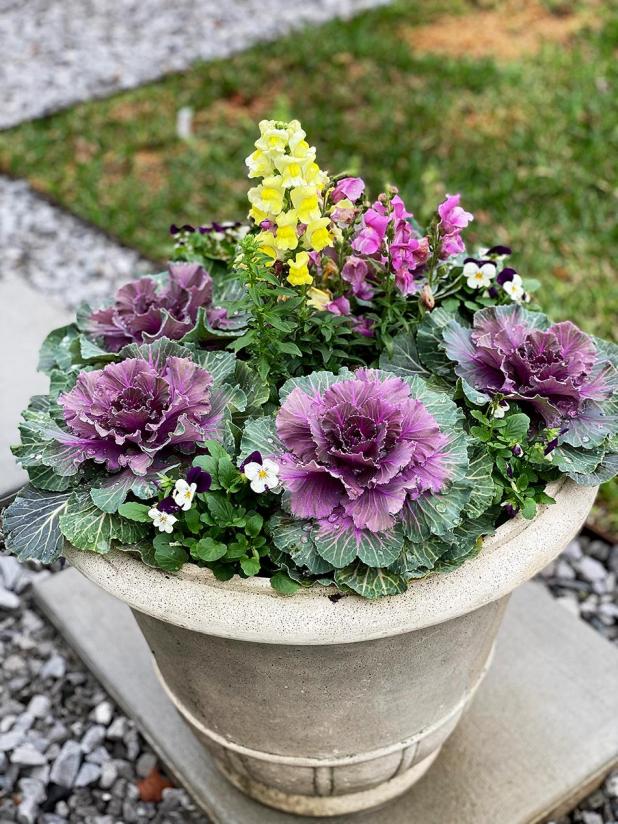
Ornamental kale, snapdragons and Sorbet violas make a dazzling container plant display.
—LSU AgCenter/Heather Kirk-Ballard
Get It Growing: Caring for container plants
Growing plants in containers can be very convenient. For one thing, it makes your plants portable. Unlike plants in the ground, containers can be moved to the perfect location for their growth.
I finally threw in the towel with my citrus trees and put them in large containers on wheels. Every year my small citrus trees would die from freezing weather. Confession: I’ve been guilty of plant neglect. They’ve gotta be tough to stay in my garden. Survival of the fittest. But now I take the easy road and simply roll my trees under the patio or into the garage, and no more freezing.
Container gardening has more benefits besides freeze damage protection. I find that my pots require less weeding; plants are less prone to soil borne pathogens and insects; and I have more control over what type of substrate or media I grow them in. And they also have improved accessibility. No more walking out to the garden for kitchen herbs when they are in containers. You only need step outside your door.
On the flip side, you have to do some things to keep container plants looking good. Plants that lack proper water and nutrients can become stunted and unhealthy. They’ll flower less, and leaves will yellow.
In the summer heat, they require more work. By summertime in Louisiana, plants will be in a growing fury. Watering sometimes has to be done daily with no rain, and with that comes the need for more fertilizer. Plants will be transpiring (air-conditioning for plants — evaporative cooling) so much more and can easily become wilted in 90-plus-degree temperatures.
First things first: Make sure you plant in a large-enough container for your plant. The larger the container, the more soil to hold water and nutrients. Porous containers such as terra cotta dry out quickly, while plastic, metal and ceramic containers retain more moisture.
One of the most challenging and important things with container gardening is keeping up with watering. During summer, it seems like it’s a never-ending chore. Develop a routine to take care of container plants, and the drudgery is not so taxing.
Watering is a balancing act: too much or too little can be bad. Overwatering plants is the No. 1 killer. When plants are overwatered, roots cannot take up oxygen and plants essentially die of drowning. They have stunted growth and yellowed leaves, similar to those that are under-watered. Hence, many people continue to water, making the damage worse. Keep in mind: With excessive rain or for containers located in shaded areas, the soil tends to stay too moist.
I find it best to water containers when the soil surface becomes dry to the touch, watering each one until it begins draining from the bottom of the container, ensuring the water has reached all of the roots.
Water at the soil surface, as opposed to watering overhead, to help prevent foliar disease. Water in the mornings to ensure adequate moisture for the hot daytime temperatures. This gives foliage time to dry. Avoid watering at the end of the day when the foliage stays wet too long.
With regular watering, nutrients will leach from the container quickly. Commonly used container mixes used to fill pots lack sufficient organic matter and nutrients. So container plants benefit from adding a balanced, granular, slow-release fertilizer when they are initially planted. This will provide nutrients over several months. It is also a good practice to feed with a water-soluble liquid fertilizer every two to three weeks until the temperatures cool and watering is less often.
Use saucers to help with the watering war, especially for plants located in hot, sunny locations to help the soil retain moisture longer. Plants with dry soil sitting in wet saucers can wick up and absorb the moisture. Remove the saucers for plants sitting in shade or when the weather cools to prevent moisture retention that is unwanted.
The rest is occasional maintenance. Keep flowering containers full of blooms by deadheading (removing spent flowers), encouraging new flower production.
Also remove dead or diseased leaves. If you notice part of the plant has died, cut it back to the nearest healthy growing point or to the base of the plant. Unhealthy or dying plants are susceptible to secondary injuries such as disease and disease-carrying insects.
To tame rapid growth or to promote new growth, trim container plants back into shape. Let’s face it, overcrowded containers look messy. By midsummer in Louisiana, plants may need some serious help. You can help by cutting the plants back by half. They’ll be back to full size in just a couple of weeks. Do this in the morning or late evening to avoid stressing the plants in the heat of the day.
